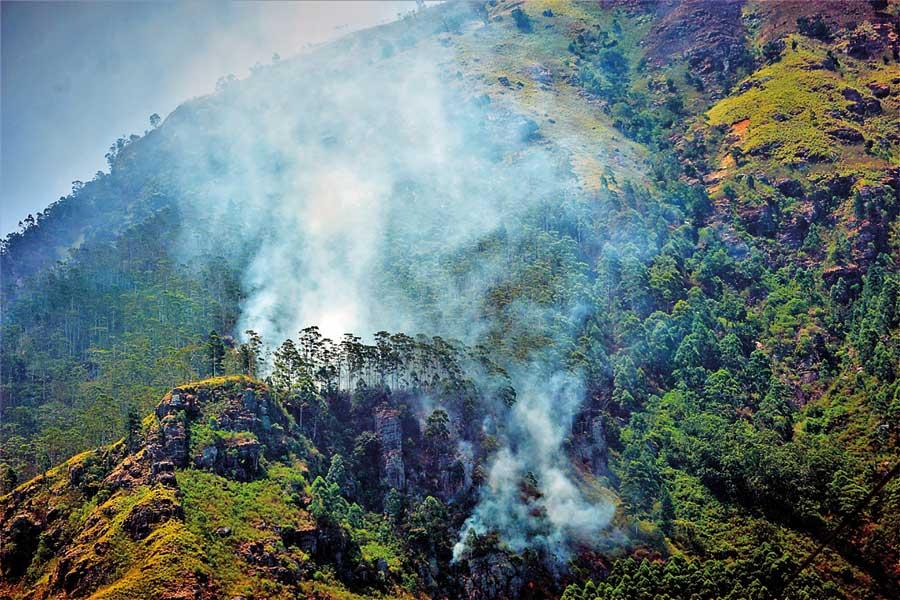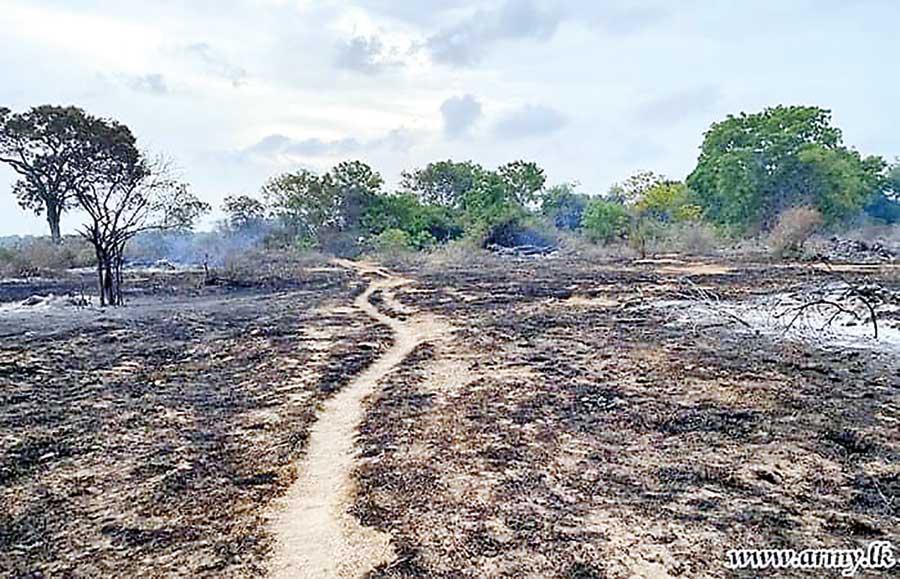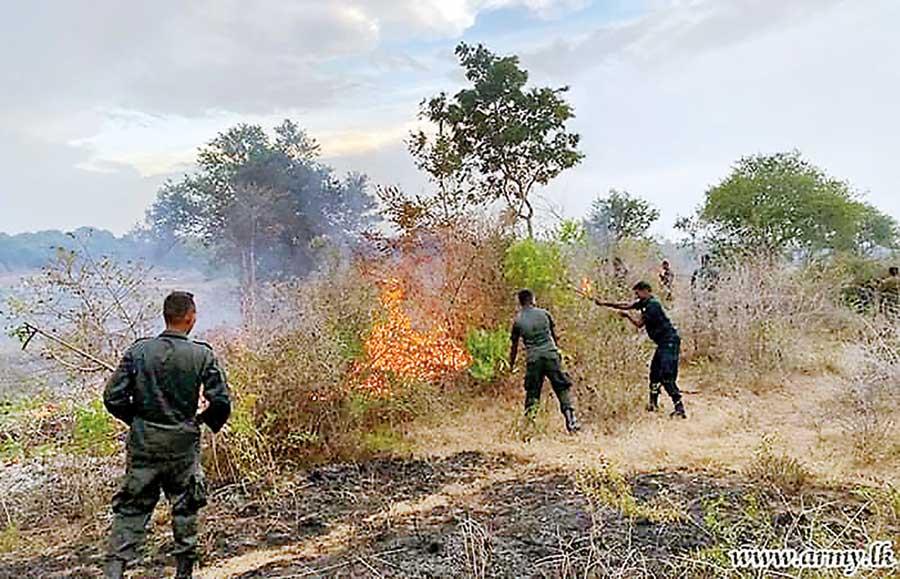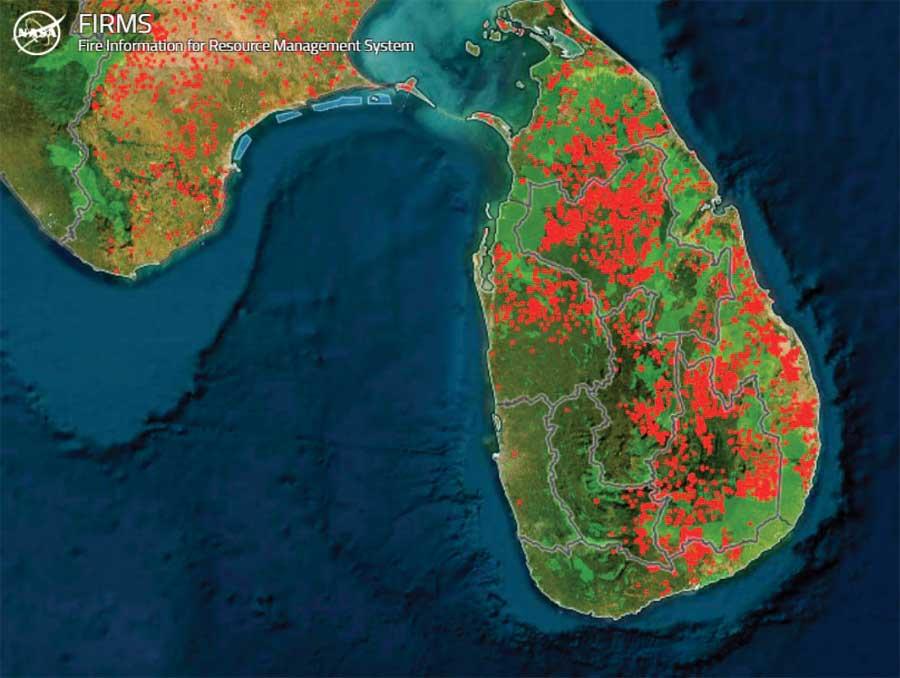21 Aug 2023 - {{hitsCtrl.values.hits}}

Wildfires do irreparable damage to forest ecosystems and increase global warming
2500 hectares. That’s the approximate extent of forests and grasslands that have been destroyed over the past seven months due to raging forest fires in Sri Lanka. Incidents of forest fires have been recorded from several areas across the island including the Thabbowa sanctuary, Rakwana-Navinna montane forest, Angunuwelpelessa forest reserve, Randenigala forest reserves, Belihul Oya, Balangoda sub-montane forests and Ohiya upper montane forests. Although extreme heat is one of the natural causes for forest fires, conservationists opine that in a majority of incidents, the main reason is carelessness of humans. One of the major consequences of forest fires is that it negatively impacts the health of rivers, lakes and streams.
seven months due to raging forest fires in Sri Lanka. Incidents of forest fires have been recorded from several areas across the island including the Thabbowa sanctuary, Rakwana-Navinna montane forest, Angunuwelpelessa forest reserve, Randenigala forest reserves, Belihul Oya, Balangoda sub-montane forests and Ohiya upper montane forests. Although extreme heat is one of the natural causes for forest fires, conservationists opine that in a majority of incidents, the main reason is carelessness of humans. One of the major consequences of forest fires is that it negatively impacts the health of rivers, lakes and streams.
August : The peak season for forest fires
Although there is no precise information regarding the number of forest fires, one of the assumptions is that more than 80 recorded forest fires have occurred around the nation based on incident reports and other information. “According to the NASA Fire Information for Resource Management System’s fire map, the entire nation has been on fire for the past 31 days,” said Sethil Muhandiram, conservation researcher and Executive Director at Leopocon Sri Lanka. “The Disaster Management Center estimates that there are between 50 and 200 forest fires in Sri Lanka each year. At least 673 forest fires have been documented between 2016 and 2019. The Department of Forest Conservation estimates that around 5619 hectares of land have been destroyed due to forest fires by the year 2020.The majority of forest fires happen between June and September, peaking in August.”
Gravity of human carelessness
Sri Lanka’s forest cover is on its decline and the main causes are deforestation and forest degradation. “The primary cause of deforestation, which has a significant impact on forest resources annually, is forest fires. In Sri Lanka, forest fires are primarily caused by human carelessness. The weather, the many types of fuel in the forest, and local attitudes can all be used to characterize the issue of forest fire in Sri Lanka. Since Sri Lanka is not home to agents that causes natural forest fires, such as dry thunderstorms or volcanic eruptions, all fires are caused by humans. The primary culprit appears to be carelessness. Arson, unintentional ignition, or the uncontrolled use of fire in land clearance and agriculture, such as slash-and-burn farming, are a few examples of human-caused fire sources.The spread of forest fires may be caused by the tendency toward higher temperatures, dry periods, less rainfall, and humidity,” Muhandiram added.
Another source of forest fires is Hunting-related forestfires which are frequently done with deliberate intentions. “Hunters pursue animals including wild boar, rabbits, deer, sambars and pheasants. After burning the forest, some wild creatures come to consume the ashes. When they burn the forest, they set up animal traps to catch these animals.Forest fires help farmers to provide “jungle-based feedings” for cattle herds. By lighting fires in the dry season, they hope that new grass will bloom in the rainy season. The other reasons include the burning of damaged woodlands for relocating farming and the gathering of bee honey. They use smoke to keep flies away, but once they have collected the beehives, they throw the firing materials into the forest.”

As a result of wildfires, many animals lose their habitats
How forest fires affect the health of waterways
More than the risk to property or people, forest fires may result in increased levels of environmental harm and financial losses in numerous ways.“Igniting forestry areas, including protected areas like Thabbowa sanctuary or other forest areas within our climate zones may negatively impact the health of rivers, lakes, and streams both immediately and over time. Stormwater runoff is the effect of wildfires that is most easily seen. The ground’s soil changes following the absence of vegetation, becoming hydrophobic and preventing water absorption. Due to the inability to absorb water, debris and silt are encouraged to be transported into larger bodies of water, further contaminating important and necessary resources. Flash floods following a fire pose a risk and enable the introduction of heavy metals from ash and soil to reach waterways,” Muhandiram explained.
Climate change hastens the effects of these fires on many species. Many of the more migratory species escape these fires to survive. However, because of human development, their habitat has significantly diminished, leaving them with fewer places to roam. They sometimes get trapped by the fire due to human habitation in the surroundings, making it unable to make a quick escape. There isn’t a way out. One of the coping techniques of these species is to simply flee the fire, although they are less adept at doing so now than they formerly were. This will result in more conflicts between humans and elephants and other wild animals,” Muhandiram warned.
Disaster management response
Whenever a wildfire is being reported, the disaster response teams do their best to douse the fires. From a conservationist’s point of view, Muhandiram observes that the disaster management response teams are doing a great job in collaboration with many parties to mitigate spread of wildfires after observing such incidents. “But yet it’s important to map the forest fire with vulnerable forest type, and earmark impacted forest types with administrative areas while formulating a community-based information collection method to avoid or to prevent wildfire ignition attempts within identified areas. Government officials can use fire ignition points which can be downloaded from NASA, (MODIS satellite data) and other technologies to monitor and observe heat signatures within forest areas which save time while it will help protect important ecological areas of the country. Its important for countries like us to prevent incidents before starting than fighting with fires after. Also its important to carry out aerial surveillance to monitor fires within identified high risk areas.”
Execution of stringent laws to prevent people from igniting forest fires, ensuring that the authorities follow all the local regulations and laws when it comes to lighting up fires, especially when igniting outdoors goes a long way. “These laws apply to specific dry-weather times of the year, so authorities should be on the lookout for those as well. Strict action can be taken against those who induce wildfires under the Forest Conservation Act and other ordinances and laws within the country. On the other hand we need proper technologies to attend to these forest fires. Modern technologies like firefighting equipment, airships and other requirements should be provided for disaster management and fire fighting teams. These teams must be well trained and qualified while responsible parties should make sure that these teams are well equipped when it comes to forest fire situations.”

Disaster response teams in attempts to minimise the damage
Wildfires and ecological imbalance
Speaking about the irreversible impact on forest ecosystems due to raging wildfires Muhandiram said that unfortunately, the absence of vegetation increases erosion, decreases the availability of nutrients in the soil, and increases the danger of disease and pest infestations, all of which have a considerable negative impact on ecosystems. “These, in turn, may delay regeneration or change what sprouts in the burned region. Furthermore, vegetation that once provided a habitat can endanger the ability of species to survive. Forest vegetation being one of the greatest carbon sinks in the world, can absorb 7.6 billion metric tons of carbon dioxide yearly, making its preservation essential.The places that are least likely to recover from a wildfire are the principal targets of cleanup operations for vegetation. In places that experience regular wildfires, rehabilitation can typically take longer than a year,” he added.
Naturally, wildlife suffers greatly when the land and water are damaged. “Natural selection depends on the results that follow.The consequences of wildfires on herbivores like grazing mammals and insects are especially concerning, because these latter species are responsible for key ecological processes like nutrient cycling and pollination. According to studies, wildfire toxins in water bodies reduce the immunity of wildlife, putting them at risk of illness and higher mortality. In a wildfire, many people lose their houses and food. Animals who were harmed by the fire may need to be moved to shelters or rehabilitation centers before being released into a suitable environment as part of cleanup activities.”
He further said when animals are displaced by fire, they will often take the opportunity to hunt and feed in newly depopulated areas, while predators may take advantage of reduced cover to hunt predatory species and it will affect on species population and make unwanted unbalance within ecosystems. “Large predators like leopards may run away from affected areas due to lack of preys and may end up entering human settlements thus leading to human-leopard conflicts. This will also have negative consequences on large herbivore species like elephants as well.”
“Another significant impact of these destructive fires is the reduction in insect pollination,” he added. “In recent years, pollinators have drastically decreased all throughout the world, mostly as a result of human activity. Numerous insects could be eliminated and some ecosystem functions could be impacted by a huge fire.”
Wildfires do irreparable damage to forest ecosystems and increase global warming by releasing carbon dioxide and other pollutants into the atmosphere. “As a result, excessive levels of pollutants are inhaled by individuals, causing miles-long migrations of smoke and haze that threaten public health. Uncontrolled wildfires destroy property and natural tourist attractions like forests and national parks, resulting in annual economic losses amounting to billions of dollars.”

Sethil
Community engagement
Many forest fires are reported from remote areas in the country. As such, local communities can play a pivotal role in mitigating forest fires. “Discussions on community participation in forestry, including forest and land fire prevention, are often dominated by powerful actors such as policy makers and companies and exclude citizens.Therefore, it’s highly important to educate them on negative consequences on forest fires and their impacts in the long run. While making awareness, an urgent need is to develop a series of training sessions on monitoring forest and land fires on selected community members to avoid harmful ignitions and to provide information related to forest fires. It’s mandatory to get their suggestions or opinions on fire control and controlled fires.” Muhandiram further suggested the use of smartphones to record incidents of forest fires. “Smartphones are currently equipped with a camera to take videos and photos, a microphone to record sound, a GPS (global positioning system) to determine coordinates, a compass, a touch screen and an internet connection. Familiarizing technology to the rural communities, specifically the younger generation may help reduce forest fire incidents and its always important to work closely with rural communities to mitigate forest fires during identified periods of time.”
“It is also important that residents understand the science behind fire hazards. Citizens need to be linked with scientists who will process and analyze the data collected by the information intermediaries. The Forest Watcher application can act as a liaison between citizens and scientists,” he further said while adding that media too can be a bridge between citizens and responsible authorities to mitigate wildfires.
Periodic fires may be beneficial
Wildfires are destructive forces, but they can occur naturally. Muhandiram observes how certain plants and animals have evolved to depend on periodic wildfires for ecological balance. “Prescribed burns can mimic the benefits of wildfires while also lowering the risks associated with larger, uncontrolled fires.The notion that a fire, which destroys plant life and puts animals at risk inside an environment, may improve ecological health may seem contradictory. However, as fire is a natural occurrence, nature has changed as a result of it. Periodic fires are beneficial to many ecosystems because they sweep out decaying organic matter; some plant and animal populations depend on the advantages of fire for survival and reproduction,” he said in conclusion.

The NASA Fire Information for Resource Management System’s fire map shows how the entire nation has been on fire for the past 31 days. Wildfires have occurred in areas marked in red
25 Dec 2024 2 hours ago
25 Dec 2024 3 hours ago
25 Dec 2024 4 hours ago
25 Dec 2024 4 hours ago
25 Dec 2024 5 hours ago